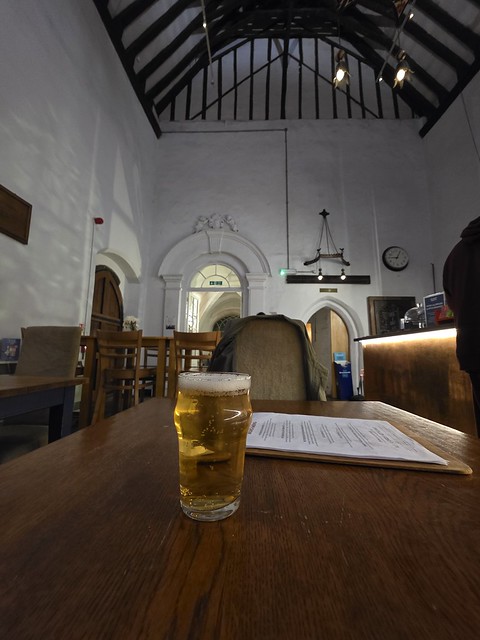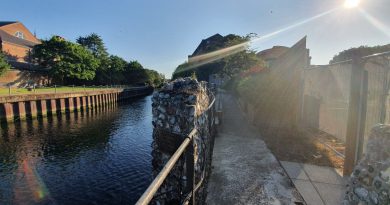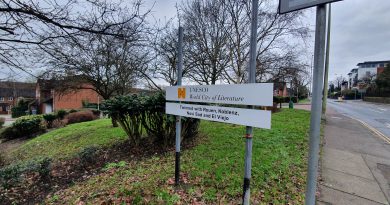Norwich – Cinema City Bar (Two Julians)
Julian suggested for the second evening visit of the night that we should visit the Cinema City bar. Now, this was a decent idea, but it’s such a complex building that there’s quite a lot of history to uncover. Julian has had some significant involvement here over the years, but I’ll let him tell those stories over a pint…. It’s an historic building which opened as a cinema in April 1978 and it was remodelled between 2004 and 2007 to add more screens. George Plunkett took a photo from around this location in 1936 and it looks relatively unchanged from the exterior. Here’s one of the frontage of the building from the same time period, showing what is now the entrance to Cinema City.
The courtyard of the building. So, as I understand, Cinema City is formed of two buildings:
(i) Suckling House – This is the core medieval part of the building which faces onto St Andrews Street. It’s a Grade I listed merchant’s house with origins dating back to the early 14th century (around the 1320s). It’s named after the Suckling family (Robert Suckling was Mayor of Norwich) who owned it in the 16th century and it stopped being used as a residence around 1915, today being the restaurant and bar area of the cinema.
(ii) Stuart Hall – This hall was added to the east side of Suckling House. It was part of a restoration project funded by Ethel Mary and Helen Caroline Colman (of the Colman’s Mustard family) in 1923. They gifted the restored Suckling House and the newly added Stuart Hall (designed by local architect Edward Boardman) to the City of Norwich in 1925 for public and educational use. Stuart Hall was equipped with cinema projection facilities from early on and this is the area of the building where the cinema screens are located.
Two medieval doorways survive in Suckling House and it was originally constructed as a hall house. Julian correctly remembered the building was descheduled in 1997, but it remains protected and is known as one of the city’s most historic buildings. It has obviously required some clever and innovative thinking to ensure that the building could be modified to become a cinema and remain in usage, but to also ensure that it remained suitably protected.
The dining room area. I didn’t go in here as I didn’t want to disturb the sole table of diners. The building was partly demolished by the construction of a tramway, although not as much as the building opposite, but the listed building record mentions that some of it was restored back again. I am going to copy the building survey here as I think it’s a definitive record and offers a more detailed background than I can offer:
“The Great Hall of Suckling House is generally agreed to be 14th century, although opinions about the precise date vary. The original entrance to the hall would have been through one of the two doors which face one another at the western end of the hall. This would have led into a screens passage which, on the western side led to service rooms in vaulted bays, and to the east into the open hall. The screen was probably timber, and no trace remains. The area where the cinema foyer is today was originally part of the Little Parlour, and fragments of the wall survive in the north and south walls. In the south wall at first floor level a medieval door still exists, and may represent the original entrance to the Solar from an external stair.
The ground floor of the western range would have served as the service wing. Three vaulted bays survive, with evidence for another in the panelled room. This latter bay has fragmentary remains of vault webbing and is thought to have been the buttery, with the larder to the south, and further south were kitchens. There is much speculation about whether the service wing is earlier or later than the hall. The awkward junction between the original southern door and the vaults suggest that the two buildings cannot be contemporary. The layout of the hall follows the typical Norwich format of having the principal living rooms separated from the street by service rooms.
Early in the 16th century a long covered passageway was added to the north of the hall, leading out from the screens passage towards the counting house. This had open sides with oak posts and decorated spandrels, one with the Grocers’ Arms and another with the arms of St Andrew. The inventory of Robert Suckling (1589) has allowed a conjectural plan of the building to be drawn up. In the 17th century the building begins to be broken up. In 1608 the buildings were divided into northern and southern sections and sold separately. The wine merchant Philip Rose who bought Suckling House from 1819 is believed to be responsible for the insertion of a cellar in the Great Hall by raising the floor. Wine merchants continued to use the building until 1914. In the 17th century the western range was refaced . The Great Gate that once stood just south of the Counting House was blocked off and incorporated into a house of six bays which appears Georgian, but is in fact just refaced.”
A rather lovely window which has some seating located within it. There’s some stained glass at the top of the window, although it’s hard to make out from this photo.
For reference, this is the pizza menu. The pricing is a little punchy, but it’s in quite a decadent building which is generally frequented by, let’s be realistic, a relatively middle-class audience.
The main menu.
That’s some ceiling arrangement.
Spot the smoke alarm in the rafters which it feels must be entirely sub-optimal to have to change.
The bar area and it’s perhaps a little cluttered, but they are trying to sell snacks to cinema goers, so I understand that. The service was friendly, personable and efficient, so the vibe was welcoming.
And finally the beer, which was pretty much the only option and there’s no cask available at all. The beer is the Mosaic Pale Ale from Adnams, but this is the keg version which was light and hoppy, but a little too cold and I think it’s simply better in cask form.
This venue is one that is probably over-looked by many drinkers in the city and I have to confess that it has never occurred to me to come here. But that’s what you get for being friends with Julian, an encyclopaedia knowledge of every watering hole in Norwich. It’s a little pricey and the beer selection is limited, but the surroundings are historic and on that basis alone, it’s worth a visit.













